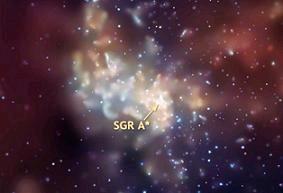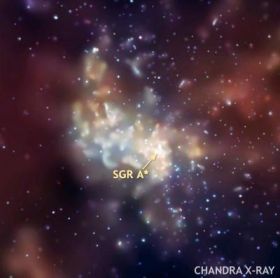| |
|
|
طغیان سیاهچاله مرکزی راه شیری
|
|
مشاهدات
جدید نشان میدهد سیاهچاله مرکزی راه شیری 300 سال پیش با
طغیان بزرگی از خواب بیدار شده است.
چرا سیاهچاله مرکز راه شیری اینقدر آرام است ؟ این سوال بی
جوابی است که مدت هاست ذهن ستاره شناسان را به خود مشغول
کرده .
ممکن است شما نیز مانند بعضی از ستاره شناسان گمان کنید که
سیاهچاله مرکز کهکشان ما(راه شیری) یکی از ان سیاهچاله های
همیشه آرام و خاموش است ، اما تحقیقات جدید چیز دیگری را
نشان می دهد.
یک گروه از ستاره شناسان ژاپنی نشان دادند که سیاهچاله ابر
پرجرمی که در قلب کهکشان ما قرار دارد همانند دیگر
سیاهچاله ها فعال و پرخروش است . و تنها مدت کوتاهی است
که استراحت می کند .
این ستاره شناسان با استفاده از تلسکوپ فضایی نیوتون (XMM-Newton )
شواهدی به دست آورده اند که نشان میدهد این سیاهچاله در
300 سال پیش انفجار و طغیان بزرگی را پشت سر گذاشته است .
این سیاهچاله که با نام Sagittarius
A-star (A*), شناخته
می شود یک هیولای فضایی واقعی است که 4 میلیون برابر از
خورشید سنگین تر است . با اینحال میزان انرژی ساطع شده از
محیط آن میلیون ها بار از تشعشعات ساطع شده از دیگر
سیاهچاله های دور ضعیف تر است .
سیاهچاله مرکز کهکشان ما در یک خواب سنگین بسر می برد و
این چیزی است که باعث تعجب ستاره شناسان شده. اما تحقیقات
جدید نشان می دهد که این سیاهچاله همیشه تا این حد آرام
نبوده و در گذشته ای بسیار فعال دارد .شاید حالا در حال
استراحت بعد از یک طغیان عظیم باشد!!.

هنگامی که پرتو های اشعه ایکس در اثر یک ظغیان به گازهای
اطراف سیاهچاله ها می رسند آن ها را در این طول موج(اشعه
ایکس) برای مدت کوتاهی روشن می کنند و با پایان یافتن پالس
اشعه ایکس آن گازها دوباره تاریک می شوند . این بازتاب یک
انفجار در کیهان است . این اتفاق برای سیاه چاله مرکزی راه
شیری نیز افتاده و ستاره شناسان با جمع آوری مشاهدات خود
بین سال های 1994 تا 2005 بازتاب طغیان عظیم این سیاهچاله
را در فضا مشاهده کردند .
یکی از این ابرهای گاری که با نام قوس- B2 (Sagittarius
B2 )
شناخته می شود ، درحدود 300 سال نوری با سیاهچاله مرکز
کهکشان فاصله دارد(300 سال طول می کشد تا نور از سیاهچاله
مرکز کهکشان به آن برسد) . مشاهده فرایند بالا در مورد این
سحابی به این معنی است که 300 سال پیش طغیانی بزرگی در
سیاهچاله کهکشان ما بوقوع پیوسته است .
دانشمندان با مشاهده این منطقه به مدت 10 سال دریافتند که
سیاهچاله مرکزی راه شیری در حدود 300 سال پیش طغیان عظیمی
را پشت سر گذاشته و شراره ای را از خود ساطع کرده که یک
میلیون برابر مقدار کنونی اش روشن می کرده است .
توضیح
این که چگونه ممکن تشعشعات خروجی از یک سیاهچاله تا این حد
نوسان داشته باشد بسیار مشکل است و خود می تواند موضوع کار
جدیدی برای ستاره شناسان باشد .شاید انفجار یک ابرنواختر
در همسایگی سیاهچاله باعث شده تا میزان زیادی از گاز و
غبار به طرف سیاهچاله پرتاب شده باشد و این تغذیه آنی و
زودگذر باعث شده تا سیاهچاله آن تشعشع عظیم را تولید کند.
Milky Way’s Giant Black Hole Awoke from Slumber 300 Years
Ago
April 16 2008
Using NASA,
Japanese,
and European
X-ray
satellites,
a team of
Japanese
astronomers
has
discovered
that our
galaxy’s
central
black hole
let loose a
powerful
flare three
centuries
ago.

This Chandra
image shows
our Galaxy's
center. The
location of
the black
hole, known
as
Sagittarius
A*, or Sgr
A* for
short, is
arrowed.
Credit:
NASA/CXC/MIT/Frederick
K. Baganoff
et al.
The finding helps resolve a
long-standing mystery: why is the Milky Way’s black hole so
quiescent? The black hole, known as Sagittarius A*
(pronounced "A-star"), is a certified monster, containing
about 4 million times the mass of our Sun. Yet the energy
radiated from its surroundings is billions of times weaker
than the radiation emitted from central black holes in other
galaxies.
"We have wondered why the Milky Way’s
black hole appears to be a slumbering giant," says team
leader Tatsuya Inui of Kyoto University in Japan. "But now
we realize that the black hole was far more active in the
past. Perhaps it’s just resting after a major outburst."
The new study, which will appear in
the Publications
of the Astronomical Society of Japan, combines results
from Japan’s Suzaku and ASCA X-ray satellites, NASA’s
Chandra X-ray Observatory, and the European Space Agency’s
XMM-Newton X-ray Observatory.
The observations, collected between 1994 and 2005, revealed
that clouds of gas near the central black hole brightened
and faded quickly in X-ray light as they responded to X-ray
pulses emanating from just outside the black hole. When gas
spirals inward toward the black hole, it heats up to
millions of degrees and emits X-rays. As more and more
matter piles up near the black hole, the greater the X-ray
output.
These X-ray pulses take 300 years to
traverse the distance between the central black hole and a
large cloud known as Sagittarius B2, so the cloud responds
to events that occurred 300 years earlier. When the X-rays
reach the cloud, they collide with iron atoms, kicking out
electrons that are close to the atomic nucleus. When
electrons from farther out fill in these gaps, the iron
atoms emit X-rays. But after the X-ray pulse passes through,
the cloud fades to its normal brightness.
Amazingly, a region in Sagittarius B2 only 10 light-years
across varied considerably in brightness in just 5 years.
These brightenings are known as light echoes. By resolving
the X-ray spectral line from iron, Suzaku’s observations
were crucial for eliminating the possibility that subatomic
particles caused the light echoes.
"By observing how this cloud lit up and faded over 10 years,
we could trace back the black hole’s activity 300 years
ago," says team member Katsuji Koyama of Kyoto University.
"The black hole was a million times brighter three centuries
ago. It must have unleashed an incredibly powerful flare."
This new study builds upon research by several groups who
pioneered the light-echo technique. Last year, a team led by
Michael Muno, who now works at the California Institute of
Technology in Pasadena, Calif., used Chandra observations of
X-ray light echoes to show that Sagittarius A* generated a
powerful burst of X-rays about 50 years ago — about a dozen
years before astronomers had satellites that could detect
X-rays from outer space. "The outburst three centuries ago
was 10 times brighter than the one we detected," says Muno.
The galactic center is about 26,000 light-years from Earth,
meaning we see events as they occurred 26,000 years ago.
Astronomers still lack a detailed understanding of why
Sagittarius A* varies so much in its activity. One
possibility, says Koyama, is that a supernova a few
centuries ago plowed up gas and swept it into the black
hole, leading to a temporary feeding frenzy that awoke the
black hole from its slumber and produced the giant flare.
Launched in 2005, Suzaku is the fifth in a series of
Japanese satellites devoted to studying celestial X-ray
sources and is managed by the Japan Aerospace Exploration
Agency (JAXA). This mission is a collaborative effort
between Japanese universities and institutions and NASA
Goddard.
Source: Goddard Space Flight Center
http://www.physorg.com/news127474742.html?
1 2 3 4 5 6 7 8 9 10 11 12 13 14 15 16 17 18 19 20 21 22 23 24 25
26 27 28 29 30 31 32 33 34 35 36 37 38 39 40
آخرین
مقالات |
|
|
آرشیو موضوعی

از آغاز کودکی به پدیده های
فیزیکی و قوانین حاکم بر جهان هستی کنجکاو بودم. از همان زمان دو کمیت زمان
و انرژی بیش از همه برایم مبهم بود. می خواستم بدانم ماهیت زمان چیست و
ماهیت انرژی چیست؟
|


